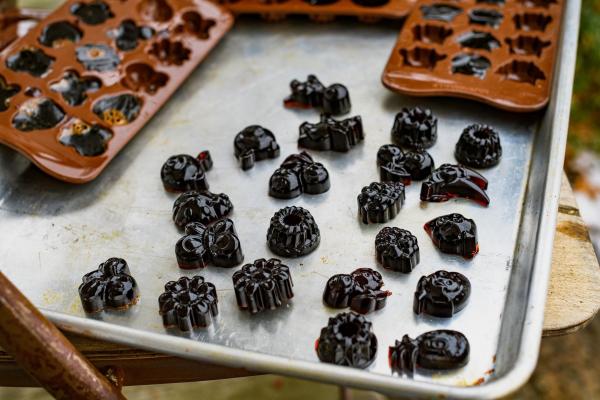
--
Lyme, Conn.
Sour patch kids, ring pops, jumbo candy bars, and the new top “worst” candy: sugar dip sticks dipped in yet more sugar. Many parents and grandparents worry about the appealing packaging, attractive names, and bright colors in the baskets of candy starting around Halloween time. “From Halloween right through New Year’s, it seems like one prolonged sugar parade,” says Jessica Somers, mom of a 9-year-old boy.
A quick scan of popular candy ingredients isn’t for the faint of heart: dextrose and modified starches, gums and esters, fructose, glucose, corn syrups, acids, artificial colors, most of which were developed between the 1940s and 1960s. While none of these have been scientifically proven to harm the human body, excesses of these in the diet do raise some serious health problems. The production of some of these ingredients involve chemicals such as hydrogen peroxide, hydrochloric acid, and bone char.
The rise of franken-candy doesn’t have to be so scary. Here are some tried and true techniques for reducing your child’s sugar, artificial colors, and preservatives intake this Halloween.
Don’t make it a battle or be too strict. Kids will start hiding the candy.
Incorporate some of the candy they get into future baking projects, like gingerbread houses, muffins, or cookies. It spreads the sugar out over a longer period of time.
As they’re munching (this is when they are quiet enough), read the ingredients to them and ask them if they know what they are. Resist a lecture here, just the simple “what’s that?” Don’t expect them to answer until the year 2042.
Have a laugh at pronouncing the ingredients — “sorbitan tristearate” and “monoglycerides” — to start their process of questioning.
Take the emphasis off of candy for other trick-or-treaters by offering them small toys, or craft/art supplies like stickers, pencils, or crayons.
Encourage any candy-eating to be done after meals (rather than by itself between meals) to reduce tooth decay.
Try making your own candy at home — you can be sure there won’t be artificial colors, preservatives, or high fructose corn syrup with a few, easy recipes.
Making candy is not difficult, and only requires a few tools (a candy thermometer and some molds). Making treats at home can instill a better sense of food appreciation. If a child knows a lollipop can be made with two ingredients (sugar and water), she or he may be more likely to question the 15-ingredient lollipop at the store. Jessica Somers says, “any non-manufactured-sugar treat alternatives are really welcome.”
Even Farmers’ Kids Love the Junk Too
Farmer Liz Farrell of Fat Stone Farm says, “My kids came home after an outing with giant gummy bears, made half-way around the world, and with the first ingredient something I had never heard of: maltose syrup. I think the total sugars in the entire bear was something like 120g. It was a great opportunity to talk about making better food choices!”
But it also spurred development of a 4-ingredient gummy kit. Their Elderberry Gummy Kit was inspired by their farm where they grow elderberries and make maple syrup, and eat as much out of their gardens as possible.
The Gummy Kit is a perfect option to satisfy children’s sweet tooth, but with no refined sugars it’s a great way to make the most of Elderberry Syrup for Kids . The fun shapes will get any child’s attention, and the recipe is so easy that kids can participate in making them (older ones can try by themselves). It comes with everything you need — just add one ice cube.
“I started substituting our own ingredients in various candy recipes at home — honey, maple syrup, and stevia — with mixed results” says Farrell. After a year of testing, she perfected the gummy treats with four ingredients: elderberries, apples, maple syrup, and gelatin. The gelatin is kosher, and adds protein and a great, smooth texture. Maple syrup for sweetening — add more or less according to your sweet-tooth, and the elderberries add antioxidants, anthocyanins, and other dark-berry benefits. The apple flavor balanced out the tart/bitter profile of the berries.
For ordering, recipes, and more information, visit their website at Fat Stone Farm
Release ID: 430130

